Pictured Above: Utilizing a mechanical background, John Cooper, precision farming manager with Swiderski Equipment, notes that his role requires a mix of mechanical innovation and technological savvy to succeed.
Many dealerships have seen at least a slowdown in precision business during the last few years, in some cases allowing for companies to regroup and reset. That hasn’t been the case for Swiderski Equipment, and more specifically, precision farming manager John Cooper.
Precision revenue has tripled to close to $1.5 million annually during the last 5 years at the 5 store New Holland & AGCO dealership based in Mosinee, Wis., challenging Cooper and his 3 person precision team to keep pace with seasonal demands.
Affectionately known simply as “Cooper” to his professional peers and customers alike, he spent 8 years as a mechanic at another dealership, before transitioning into precision farming. With the precision technology aspect of the dealership operating as a separate business, Cooper embraces the versatility of his position.
“A mechanical background is valuable, because knowing how tractors and equipment operate helps troubleshoot and problem-solve the technical issues,” he says. “Sales requires a different approach, but I view myself as a consultant to customers, there to sell them a solution to a problem.”
This installment of our Day in the Cab series brought some seasonal challenges — both mechanical and technological — that Cooper negotiated with confidence. Whether pinpointing a problematic harness, taking time to talk through a monitor setup on the phone or improvise a secure way to install a planter monitoring system, Cooper maintained stamina and poise throughout our 12 hour day in the cab.
6:20 a.m. Already half-awake, an email notification on my smart phone gets me the rest of the way and I pull myself out of the hotel bed in Mosinee, Wis. Forewarned that we should arrive early at the dealership, Jeff Lazewski, our manager of creative design services and I opted to make the 170 mile drive the day before and spent the night. We take full advantage of the hotel’s breakfast buffet and fill our plates with sausages and a waffle, with orange juice to wash it all down. It’s a crisp, but sunny spring morning and we each grab a coffee for the road from the neighboring gas station before heading out.
Dealer Takeaways
• A mechanical background can be an asset when troubleshooting technological problems that go beyond the hardware.
• Field-testing systems with a customer ensures technology is properly calibrated and operating at the farmer’s comfort level.
• Utilizing a simple, yet accessible time management mobile app can help track and bill service visits.
7:28 a.m. Pulling into the parking lot at Swiderski Equipment, there are several cars and service trucks scattered around the main building. It’s an expansive lot bordered by woodlands with a variety of equipment, including compact tractors, balers and sprayers alongside the road. Catching our eye is a prominent “Bargain Row” sign calling attention to several used pieces of small ag machinery on display.
7:57 a.m. Several employees file out of the main building including Melissa Heise, Swiderski’s marketing manager. We had met at the 2017 Precision Farming Dealer Summit in St. Louis where she moderated a roundtable on ag drones. She informs us a monthly multi-department staff meeting just finished and she escorts us to the building across the lot that houses the precision farming department. She notes that this time of year, on the cusp of spring planting, “precision farming takes over everything.”
8:07 a.m. The precision specialists’ building is modest, with a medium-sized service bay and makeshift offices for each of the Swiderski’s 3 Precision Farming Division specialists. Aside from planter setups, equipment installations and technical support is largely done on customers’ farms. John Cooper arrives, carrying a box of Trimble components under his arm. He acknowledges us, “Are you guys ready for an exciting day?” but then ducks into the office of a newly hired specialist. Cooper preps him for the day ahead with a few priority service visits. Melissa notes that the 3 specialists are responsible for maintaining 100% of the precision business throughout the dealership’s 5 stores and a coordinated effort is essential to keeping pace with customer demand.
8:22 a.m. We have several customer visits scheduled, but before departing the dealership, Cooper inspects a new 12 row White planter scheduled to be delivered to a customer. Cooper and his team are about done with pre-season planter setups, but still have a few being shipped to the dealership and scheduled to be delivered to customers during the week. He admits this is an anxious time of year to be waiting for planters when customers are especially impatient. Fortunately, a rainy stretch has allowed the precision team to momentarily catch up, but Cooper knows it won’t last. “My philosophy is, if I can get 4 jobs done in a day, I can get a little ahead, and we do all our planter setups in advance. But there’s always going to be something that breaks, so we’re always busy.”
8:35 a.m. Satisfied with the planter run through, Jeff and I hop into Cooper’s service truck and stop at a gas station en route to our first visit of the day. Cooper grabs a Red Bull and a couple of Bodyarmor energy drinks that qualify as “breakfast.” He jokes that every spring he goes on an unplanned diet because there’s not often time to break for lunch during planting season.
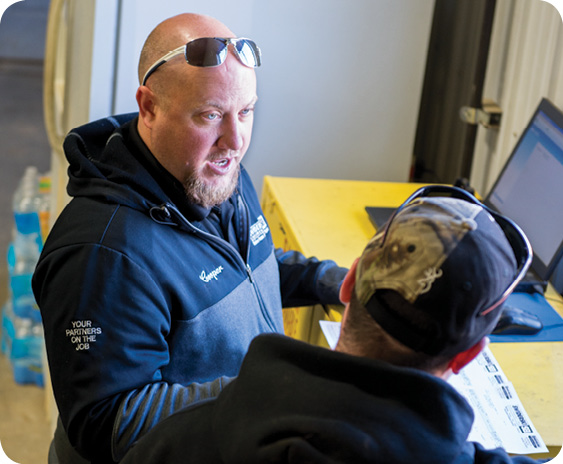
John Cooper takes pride in mentoring Swiderski’s 3 Precision Farming Division specialists. Constant communication throughout the day is essential to keeping customers satisfied and specialists efficient with their time.
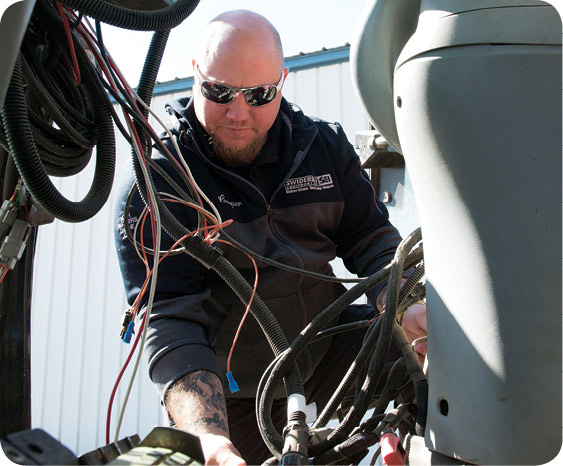
Armed with an array of wrenches, John Cooper navigates through a customer’s wiring harness. “It’s a standalone harness, so this is not typical. But today, this is what we have to work with.”
9:02 a.m. Along with some impressive arm tattoos, I notice Swiderski’s motto “Your Partners on the Job” embroidered on the right sleeve of Cooper’s fleece as we head toward Stratford, Wis., and Pankratz Farms about 30 minutes away. The customers are having two Trimble FMX displays updated, along with a CenterPoint RTX activation. They are enrolled in two of about 90 precision service contracts Cooper and his team support. The tiered plans start at $400 with unlimited phone support, escalate to $650 for pre-season setup and unlimited in-field support and top out at $1,100 for application control and GPS calibration, setup and support. “When I started 5 years ago, we didn’t have anything and today, we have customers with multiple tractors on 1 farm enrolled in our plans, and they renew every year. We don’t win them all as far as the time we spend vs. the money we make, but the real value is it gets us on farms to see what guys are doing and creates opportunities for that next sale.”
9:17 a.m. We arrive at the farm and find a Massey Ferguson 8460 out front attached to a 16-row White Planter. Cooper gets right to work updating the first display in the tractor cab. Kevin Pankratz walks over and Cooper goes over the updates. “Hopefully, in an hour or two, we’ll have it all taken care of.” Kevin doesn’t appear to be in a hurry as they are in the middle of butchering a cow.
9:47 a.m. During the firmware update, Cooper begins checking the wiring harness connecting the tractor to the corn planter. Though not technically part of the support package, the Pankratz’s bought the planter from Swiderski a year ago and Cooper expects it will only take a few minutes to check. He opens up the electrical box on the outside of the tractor to reveal a rainbow of different wires, all intertwined like snakes. Before getting too deep into the harness evaluation, he calls into Trimble to renew the RTX subscription, which only takes about 10 minutes. “We are set up pretty good and all the invoices go to my email and I forward them right to the customer.”
10:11 a.m. Armed with an array of wrenches, Cooper continues to navigate through the wiring, which he notes is not a factory harness. “It’s a standalone harness, so this is not typical. They use this tractor for a lot of operations, but I know they are looking to upgrade so eventually they can just plug right into the back of the tractor. But today, this is what we have to work with.”
10:33 a.m. Before finishing the harness, Cooper does a system check, but has no power in the tractor cab. “Oh, boy, where do we have to go now,” he says. “Usually a red wire is a red wire and power, but that doesn’t seem to be the case.” After a little more investigating, Cooper reconnects a couple of wires and we hear something click in the tractor cab, which is a positive sign. “Only one wire wrong. That’s a good day,” jokes Cooper.
“95% of my job during the busy season is spent on the phone…”
10:46 a.m. The cab has partial power, but additional troubleshooting leads Cooper to believe a blown fuse is the culprit. He tests the voltage, and then consults the manual to determine which fuse needs to be replaced. Fortunately, he has a temporary 30 amp replacement in his service truck and gets it installed. We have ignition and all systems are a go. Cooper hustles over to the other tractor, an AGCO DT220 to update it’s display, which goes as planned.
10:55 a.m. Before we depart, Cooper has a brief recap conversation with Kevin about the services rendered and also encourages him to consider upgrading tractors prior to next year, to allow for a simpler and more modern connection to his planter.
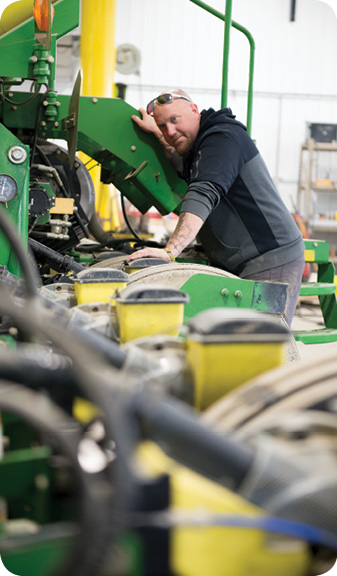
John Cooper is meticulous in making sure systems are field-ready after installation and calibration. He often finds customers and advises them to accompany him on a test run to make sure everything is operational, as was the case with this 12 row John Deere 1770 planter.
“Well, that’s one down,” Cooper says as we hop into his service truck. “I like them to go a little quicker, but we got 2 tractors done and the wiring on a planter, we did OK. Now we see what happens before the next one.”
11:15 a.m. En route to our next visit, Cooper realizes he had his phone on silent and sees he 4 missed calls and a couple of texts. “Once they start coming, I might get 100 calls a day,” Cooper says. He assesses the urgency of each call and first gets back to Mike Witzeling, store manager for Swiderski’s Antigo location, about a frantic customer wanting to know when his planter will be delivered. Cooper tells Mike to let the customer know it will be delivered this week. “It’s one we were waiting for parts to come in on, but it happens every year.”
11:22 a.m. Checking the time, Cooper decides to touch base with one of the specialists who is wrapping up a monitor calibration with a customer. We plan to meet back at the Mosinee store to see if parts for a steering system arrived. The system was on back-order and he ended up having to go through another dealer who was willing to give it up. “It’s been 2.5 weeks and it still hadn’t shipped from the manufacturer,” Cooper says. “It’s drying out and the customer wants to roll so I was going to do the job myself, but there’s no way. With another install and a planter setup yet today, I’ll be lucky to be done by 6 p.m.”
11:47 a.m. We arrive at the Mosinee store and head to the parts department to check on the expected arrival of a few planter parts. “It doesn’t look good, I don’t see any parts,” Cooper says. Cooper takes stock of what else has come in for a planter going to a customer the next day and immediately suspects that a gasket is too big — 3 inches instead of 2 inches. His fears are confirmed when he sizes up the gasket on another planter. “I’m probably going to have to go find a gasket somewhere before tomorrow afternoon.”
12:31 p.m. Back on the road, we’re headed toward Marathon City and Gary Sulzer Farms for a Trimble 1000 EZ-Pilot install. We see a couple of airplanes flying overhead spraying rye fields. “Those guys are crazy,” Cooper says. “But we did try and sell them a couple of GPS systems.” He also notes the dealership has had some limited success selling unmanned aerial vehicles, but the market has cooled considerably. “We sold a few to customers, and actually sold one to a local news channel and talked to a couple of police departments about getting one,” Cooper says.
12:45 p.m. We arrive at the farm and Cooper checks the progress of the install on a Deere 6420 tractor. Cooper jumps in the cab to assist. He offers some constructive guidance for the newest precision team member and it’s clear Cooper is both training and evaluating. With the install nearing completion, Gary Sulzer drops by for an update. Cooper assures him all is going as scheduled and says, “Hopefully we don’t have any more fires to put out.”
“We don’t win them all as far as the time we spend vs. the money we make, but the real value is it gets us on farms to see what guys are doing and creates opportunities for that next sale…”
1:46 p.m. On the way to Athens and Alan and Rick Rausch’s farm, Cooper returns a customer call with a relatively minor question about accessing field setup information on their planter monitors and then touches base with his other PLM specialist, Hayden Henry. “It’s been a pretty decent day so far. We haven’t had a steady stream of calls, yet,” Cooper says. “As long as I get my other two jobs done, I should be on schedule. The only thing I’m worried about right now is getting that planter back at the shop finished and delivered.”
2:10 p.m. As we arrive at Rausch Farms, we notice several tractors perched on the perimeter of large manure pits with lines attached for draining. With a high volume of dairies in the area, Cooper notes that manure spreading and injection are popular. “The truck will smell nice now,” he jokes. Before hopping out of the truck, Cooper opens an app called Time Tracker, which he utilizes to log and organize billing for customers who don’t have one of the precision farming service agreements. “Even with a service agreement, it’s handy to track service time and our work orders. I just punch in and out for jobs and can bill our service rate and mileage where necessary. It’s pretty helpful for warranty tracking as well.”
2:18 p.m. We find the Rausch’s Deere 8400 tractor in what appears to be a newly built shed, complete with a second story parts area and oil barrels plumbed and metered. “This is all new since I’ve been out here last,” Cooper says. He gets to work on updating the FM 1000 guidance display in the cab, which goes according to plan, and then moves to updating the Trimble Field IQ crop input control system on the 12 row Deere 1770 planter attached to the tractor.
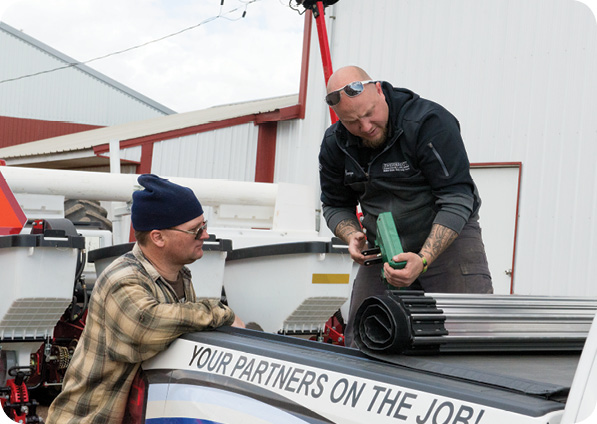
Walking the customer through a planter installation, John Cooper unboxes a half-dozen components in the back of his truck and lines them all up to take inventory. The attention to detail is part of Swiderski Equipment’s motto, “Your Partners on the Job.”
2:34 p.m. An initial systems check confirms everything is updated and functional, but Cooper wants to field test it and finds Alan Rausch. They pull the tractor and planter into an adjacent field, which fortunately is dry enough to make a few passes. “We found the roll calibration on the guidance was off a little, so we adjusted for the correct spacing and the proportional steering gain (P-gain) was a little high and the wheels were a little jerky, so we smoothed that out as well,” Cooper says.
3:03 p.m. With a brief respite in the day’s workload, we stop at a gas station for lunch on our way to the final farm visit of the day in Medford. “I should probably get something to eat before I get lightheaded,” Cooper says. “This time of year, I tend to eat a lot of gas station food.” We each get a slice of pizza and a beverage.
3:16 p.m. We arrive at Bob Rudolph’s farm and find his 6 row White planter out front. He purchased the planter last year from Swiderski, but wants to upgrade with a Precision Planting 20/20 SeedSense metering system. Cooper estimates the job will take 1-1.5 hours. He unboxes a half-dozen components in the back of his truck and lines them all up to take inventory. Everything appears to be there.
3:44 p.m. Cooper realizes he’ll need to drill new bolt holes into the row units to properly attach 3 row unit modules (RUM). He measures and marks the positions and grabs his drill from the truck only to find that the battery is nearly dead. He swaps it out with a replacement, and keeps his truck running to charge the other one, just in case.
4:26 p.m. Slowly, but surely, Cooper is progressing on the job. He’s deliberate and precise, clearly relying on his mechanical background to navigate through the necessary fabrications to ensure the system is secure. But a handful of calls continue to interrupt his momentum. “It never fails, once it gets to be about 4 p.m., they start coming in because everyone needs something done before the end of the day,” he says.
5:10 p.m. Cooper borrows a grinding wheel to shave a small amount of metal near the bolt holes to get the load sensor pins to lock in on the row unit. It’s a tedious process, but he gives Bob a step-by-step rundown of the procedure and the system, and assures him that any modifications he’s making to the equipment will be minor.
5:33 p.m. With the attachments to the planter complete, and calls continuing to come in, Cooper multi-tasks and gets to work installing the SeedSense module to the Massey Ferguson bar connecting the tractor to the planter. He measures and then drills four bolt holes to attach the module before hopping into the cab to check the connections and run Bob through the system features.
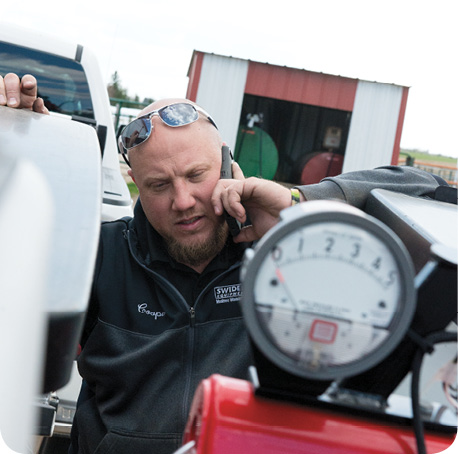
“It never fails, once it gets to be about 4 p.m., calls start coming in because everyone needs something done before the end of the day,” John Cooper says.
5:47 p.m. Checking the harness connection from the tractor to the planter, Cooper isn’t getting power to the system. He calls into Precision Planting support to troubleshoot the issue, which ends up being a different harness, which luckily was part of the installation kit. Cooper swaps them out and the sensors for all 6 rows light up. “I just wanted to hook everything up before I routed the wires and make sure it worked, otherwise I’d have to tear it all apart again to find a problem,” Cooper says.
6:01 p.m. Cooper wraps up the installation, except for having to come back and attach a mounting plate on the tractor for the GPS antenna. He gives Bob one more run through the system and patiently and thoroughly answers a couple of questions, despite the temporary distraction of another call coming in.
6:58 p.m. On the way back to Mosinee, Cooper checks in one more time with Hayden. They rehash the progress of the day and prioritize the rest of the week. A few appointments need to be shuffled and both agree that they will be increasingly busy. In between a few justifiable yawns, Cooper returns a handful of calls, mainly just checking in on customers from earlier in the day and to get a jump on tomorrow’s agenda. We arrive at the dealership and thank Cooper for another eventful day in the cab.







